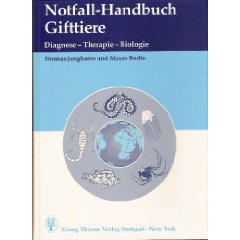|
| |
Bothrops pirajai
Namen: Piraja's Lancehead;
Lokale Namen:
Jararacucu, Jararacucu Tapete
Vorkommen: Brasilen (Bahia)
Beschreibung: Die Tiere erreichen
eine durchschnittliche Länge von 65 cm, maximal 137 cm.
Toxine: Die genaue Zusammensetzung
ist unbekannt. Es sind Fibrogenasen gefunden worden. Wahrscheinlich sind
Myotoxine vorhanden. Die Blutgerinnung wird sicher beeinflusst.
Symptome: Jeder Biss durch die
Schlange muss als potentiell lebensgefährlich eingeschätzt werden. Es existieren
keine klinischen Berichte. Wahrscheinlich sind lokale Effekte, wie Schmerzen,
Schwellungen, Blutungen, Nekrosen und Blasenbildungen. Myolysen sind denkbar.
Allgemeine Zeichen sind Kopfschmerzen, Übelkeit, Erbrechen, Durchfall,
abdominelle Schmerzen, Schwindel und Kreislaufstörungen bis zum Kollaps. Es kann
zu einer Ungerinnbarkeit des Blutes kommen.
Maßnahmen:
Die pressure-immobilization-Methode darf nicht
angewendet werden. Die betroffene Stelle ist ruhig zustellen. Der Patient muss
liegend in eine Klinik transportiert werden. Die weiteren Maßnahmen bis zur
Klinik erfolgen symptomatisch. Ein Antivenin ist vorhanden. Das Antivenin sollte
nur nach Rücksprache mit einer Giftnotrufzentrale erfolgen.
Literatur:
-

-
The Reptile Database
-
WCH Clinical Toxinology
-
Preliminary X-ray crystallographic studies of a Lys49-phospholipase A2
homologue from Bothrops pirajai venom complexed with p-bromo-phenacyl bromide
and alpha-tocopherol inhibitors.
-
Neutralization of snake venom phospholipase A2 toxins by aqueous extract of
Casearia sylvestris (Flacourtiaceae) in mouse neuromuscular preparation.
-
Biochemical and functional characterization of an L-amino acid oxidase
isolated from Bothrops pirajai snake venom.
-
A new C-type animal lectin isolated from Bothrops pirajai is responsible for
the snake venom major effects in the isolated kidney.
-
The structure of the D49 phospholipase A2 piratoxin III from Bothrops pirajai
reveals unprecedented structural displacement of the calcium-binding loop-
possiblerelationship to cooperative substrate binding.
-
Dissociation of enzymatic and pharmacological properties of piratoxins-I and
-III, two myotoxic phospholipases A2 from Bothrops pirajai snake venom.
-
Amino acid sequence of piratoxin-II, a myotoxic lys49 phospholipase A(2)
homologue from Bothrops pirajai venom.
-
Effects of Bothrops pirajai venom on the mouse extensor digitorum longus (EDL)
muscle preparation.
-
Purification and amino acid sequence of MP-III 4R D49 phospholipase A2 from
Bothrops pirajai snake venom, a toxin with moderate PLA2 and anticoagulant
activities and high myotoxic activity.
-
Crystallization and preliminary X-ray diffraction studies of piratoxin III, a
D-49 phospholipase A2 from the venom of Bothrops pirajai.
-
Crystallization and preliminary X-ray diffraction studies of piratoxin II, a
phospholipase A2 isolated from the venom of Bothrops pirajai.
-
Amino acid sequence of piratoxin-I, a myotoxin from Bothrops pirajai snake
venom, and its biological activity after alkylation with p-bromophenacyl
bromide.
-
Crystal structure of piratoxin-I- a calcium-independent, myotoxic
phospholipase A2-homologue from Bothrops pirajai venom.
-
Crystallization of piratoxin I, a myotoxic Lys49-phospholipase A2 homologue
isolated from the venom of Bothrops pirajai.
-
A quick procedure for the isolation of dimeric piratoxins-I and II, two
myotoxins from Bothrops pirajai snake venom. N-terminal sequencing.
-
Fractionation of Bothrops pirajai snake venom- isolation and characterization
of piratoxin-I, a new myotoxic protein.
- Bothrops pirajai -
Wikipedia, the free encyclopedia
-
MAVIN 2008-12-03, BOTHROPS PIRAJAI
-
Amerikanische Lanzenottern – Wikipedia
|